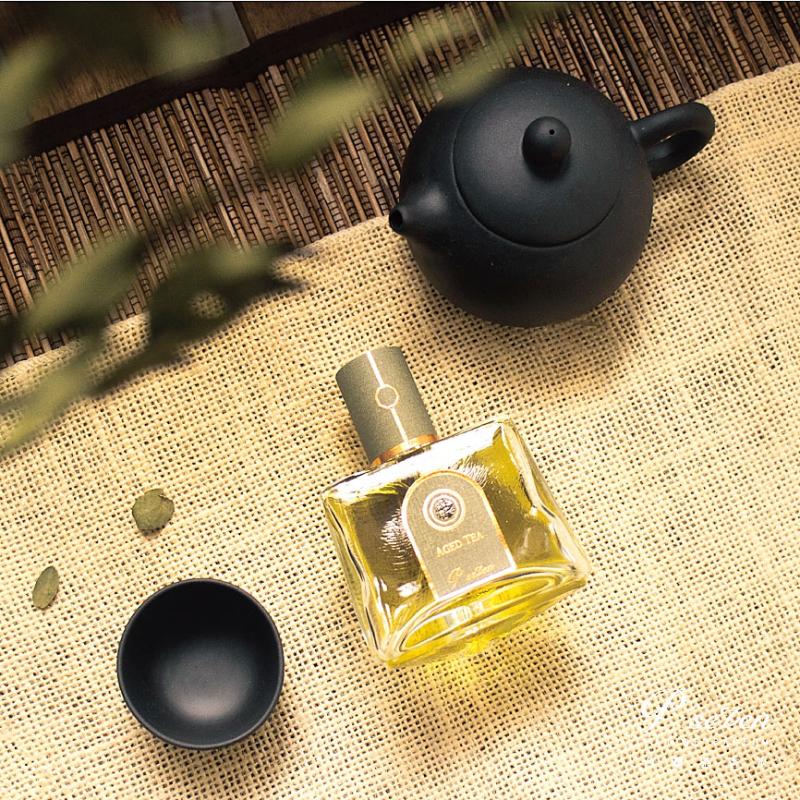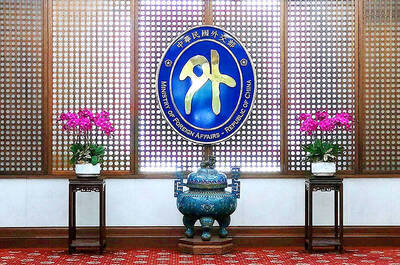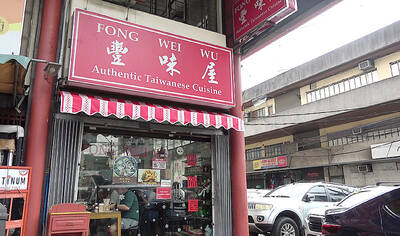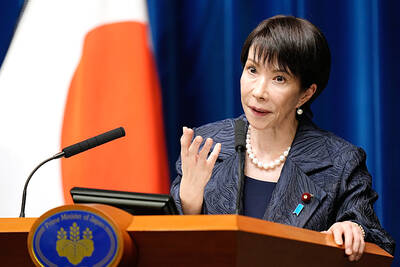A Taiwanese-made tea-based perfume won the Independent Award at the Art and Olfaction Awards (A+OA) in Miami, Florida, on Friday.
Pan Seven International’s (P.Seven) Aged Tea (暗香), designed by perfumers Pan Yu-ching (潘雨晴) and Huang Chien-shun (黃建勳), is the first Taiwanese entry to win the awards’ “Golden Pear” trophy.
The preliminary round of the competition is judged blindly, focusing solely on the scent of the perfume, after which the names and brands of the short-listed finalists are revealed, the Web site of the Los Angeles-based A+OA says.

Photo courtesy of P.Seven
The winning perfume, created by Pan, stood out in a world dominated by European and US brands.
Pan said that her creations mostly feature fresh and elegant aromas of tea leaves, which are different from European perfumes with floral or citrus aromas that are most well-known.
A former tea master, Pan said that she took up perfumery and founded P.Seven a decade ago, adding that the brand’s first product, Taiwanese Tea, was inspired by Taiwan’s “spring tea.”
While designing the perfume for the competition, Pan said that she decided to use Taiwanese aged tea as a theme to showcase Taiwan through her creation, as many people learn about Taiwan through its tea such as its famous oolong tea and oriental beauty tea.
Aged tea, which has been stored for years or even decades, has a strong aroma with slight notes of smoked plums, fruits and herbs, a blend unique to Taiwan, she said, adding that she recreated this fragrance using mostly Taiwanese produce.
With a woody and smoky base, Aged Tea gives off the elegant fragrance of aged Taiwanese tea, which is accompanied by the scent of smoked plum and the sweetness of longan, she added.
Upon learning the news of the win, Pan said that it felt “incredible,” adding that she was happy to bring Taiwan to the world, as she has always wanted to give back to her country.
P.Seven has held aroma exhibitions in Japan, Hong Kong and Shanghai, but was unable to do so in the past two years due to the COVID-19 pandemic, she said.
She has returned to her hometown, Hualien County’s Fuli Township (富里), and launched an art festival, inviting more than 20 artists-in-residence to create works of art related to the area.
She has also drawn inspiration from her hometown to create two fragrances — one that smells like rice fields and another that smells like bamboo forests — in cooperation with the Fuli Farmers’ Association and the Forestry Bureau’s office in Hualien respectively.
Aged Tea was not the only tea-based perfume recognized this year, with Oolong Tea by Hong Kong perfumer Michael Wong winning the Artisan Award.
Another notable Golden Pear winner was Viral Parfum by the Japanese olfactory artist Maki Ueda, which won the Sadakichi Award For Experimental Work With Scent.
The fragrance “uses six scent accords to represent the different mutations of” COVID-19, which together create an aroma of white lily and are only visible under black light, the A+OA said in a statement.
The Institute for Art and Olfaction, founded in 2013, launched the annual A+OA in 2014, hoping to “help generate support for independent practices in perfumery,” its Web site says.
Additional reporting by CNA

The Ministry of Foreign Affairs (MOFA) yesterday voiced dissatisfaction with the Comprehensive and Progressive Agreement for Trans- Pacific Partnership (CPTPP), whose latest meeting, concluded earlier the same day, appeared not to address the country’s application. In a statement, MOFA said the CPTPP commission had "once again failed to fairly process Taiwan’s application," attributing the inaction to the bloc’s "succumbing to political pressure," without elaborating. Taiwan submitted its CPTPP application under the name "Separate Customs Territory of Taiwan, Penghu, Kinmen and Matsu" on Sept. 22, 2021 -- less than a week after China

THE GOOD WORD: More than 100 colleges on both sides of the Pacific will work together to bring students to Taiwan so they can learn Mandarin where it is spoken A total of 102 universities from Taiwan and the US are collaborating in a push to promote Taiwan as the first-choice place to learn Mandarin, with seven Mandarin learning centers stood up in the US to train and support teachers, the Foundation for International Cooperation in Higher Education of Taiwan (FICHET) said. At the annual convention of the American Council on the Teaching of Foreign Languages held over the weekend in New Orleans, Louisiana, a Taiwan Pavilion was jointly run by 17 representative teams from the FICHET, the Overseas Community Affairs Council, the Steering Committee for the Test of Proficiency-Huayu, the

A home-style restaurant opened by a Taiwanese woman in Quezon City in Metro Manila has been featured in the first-ever Michelin Guide honoring exceptional restaurants in the Philippines. The restaurant, Fong Wei Wu (豐味屋), was one of 74 eateries to receive a “Michelin Selected” honor in the guide, while one restaurant received two Michelin stars, eight received one star and 25 were awarded a “Bib Gourmand.” The guide, which was limited to restaurants in Metro Manila and Cebu, was published on Oct. 30. In an interview, Feng Wei Wu’s owner and chef, Linda, said that as a restaurateur in her 60s, receiving an

MORE RETALIATION: China would adopt a long-term pressure strategy to prevent other countries or future prime ministers following in Sanae Takaichi’s steps, an academic said Taiwan should maintain communications with Japan, as Japanese Prime Minister Sanae Takaichi is to lead a revision of security documents, Taiwanese academics said yesterday. Tensions have risen between Japan and China over remarks by Takaichi earlier this month that the use of force against Taiwan would constitute a “survival-threatening situation” for Japan. Prospect Foundation president Lai I-chung (賴怡忠) yesterday said Takaichi’s stance regarding Taiwan is the same as past Japanese prime ministers, but her position is clearer than that of her predecessors Fumio Kishida and Shigeru Ishiba. Although Japan views a “Taiwan contingency” as a “survival-threatening situation,” which would allow its military to